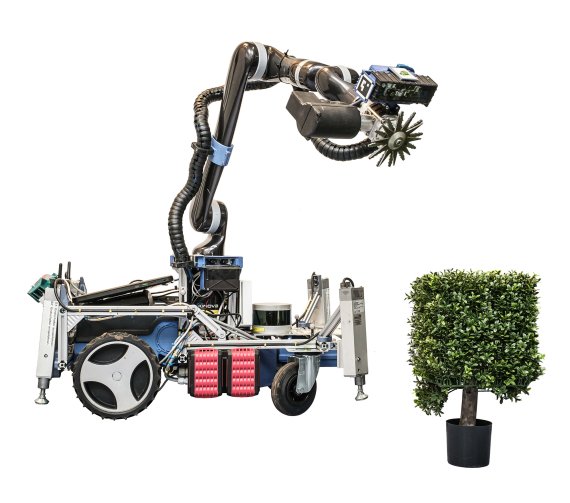You sometimes see what looks like an outsize beetle trundling over a lawn. It’s an autonomous lawnmower and it doesn’t look particularly intelligent. But what if such a machine could suddenly do more than this? Trim a hedge, for example, or prune the roses. What kind of technology would that require?
This was the question the Trimbot 2020 project was tasked with four years ago. The aim was to develop a consumer-friendly pruning robot. ‘But the end goal was not with a prototype ready for marketing. This project aims at answering questions,’ says Jochen Hemming, who heads the Wageningen team in this international project. ‘The Trimbot is a vehicle for research on autonomous navigation, robotics, image analysis technology, deep learning and miniaturization.’
Ball or cube
The choice of a pruning robot had to do with the involvement of the German manufacturer Bosch. Trimbot is really an adapted Bosch Indego lawnmower. The robot has an autonomously operating arm with pruning tools on it, with which it can trim a bush into the shape of a ball or a cube. And with a different pair of shears, it can prune roses too.
But a lot more has to happen before you will see Trimbot in a garden. It is not fast, for instance: it take 15 minutes to prune a tiny bush. Much of that time is spent calculating its task, because outdoor conditions are changing all the time. Wind, weather and especially changing lightfall complicate things for the Trimbot. ‘Then the robot has trouble figuring out its position in relation to the object,’ explains Hemming.
A lot more has to happen before you’ll see Trimbot in a garden
Wood chips or gravel
The precision of the arm leaves a lot to be desired too. That was calculated in from the start. Hemming: ‘We chose this arm because it is so light. Industrial robotic arms are more precise, but a lot heavier too.’ The current Trimbot is not very well equipped for challenging terrain, either. It can’t cope with a garden path made with wood chips, for instance, or gravel. And lastly, the apparatus, with its rotating pruning or cutting tools, is not safe. ‘When we continue developing it, that will be an important aspect,’ says Hemming.
But the project has produced a lot of worthwhile results. Hemming: ‘We have made great strides with all the important questions about motion control and computer vision. We have more idea of how that works now. We have learned that it’s no easy task to bring all that technology together in a functional, mobile pruning robot. The biggest challenge is dealing with flexible objects. That is a very different matter to robotics for the factory floor. And combining all the technologies used also demands massive calculating capacity. It is not easy to put that into such a small machine.’
HORIZON 2020-PROJECT
Trimbot is a European Union Horizon 2020 project. WUR is working on it together with manufacturer Bosch and the Universities of Freiburg, Zürich, Groningen, Amsterdam (UvA) and Edinburgh. Wageningen researchers have been working on the robotic arm, the pruning tools and the coordination between the arm and the rest of the vehicle. Some of the testing has been done in a garden behind Radix. Two Trimbots have been made, and one of them is in Wageningen. It will be on display at the Agri-FoodTech fair in Den Bosch on 11 and 12 December. There are films of Trimbot on YouTube and trimbot2020.org.
| The lightweight robotic arm | The lightweight robotic arm, originally developed for use on a wheelchair, is made of carbon fibres. It can be moved in any direction. |
| Six camera’s | A little box of five cameras creates a 3D image and steers the movements of the ‘hand’ with the shears. |
| The pruning shears | The pruning shears consist of two circular blades, the outer of which rotates. To prevent twigs from escaping, the inner blade is serrated. |
| Wreath of camera’s | A ring of 10 cameras provides a 3D view of the surroundings. The cameras are essential for the robot’s navigation of the garden. |
| Accu’s | Two batteries on the sides provide power for the various parts. The batteries for the vehicle itself are on the underside. chillende onderdelen. Onder het karretje zitten de accu’s van het voertuig zelf. |
| Supports for stability | Retractable supports at the corners provide stability during pruning. |
| Gaminglaptop | Processing all the visual information takes a lot of calculating capacity. Trimbot uses ‘gaming laptops’ with powerful processors for that. |

 Photo: Guy Ackermans
Photo: Guy Ackermans